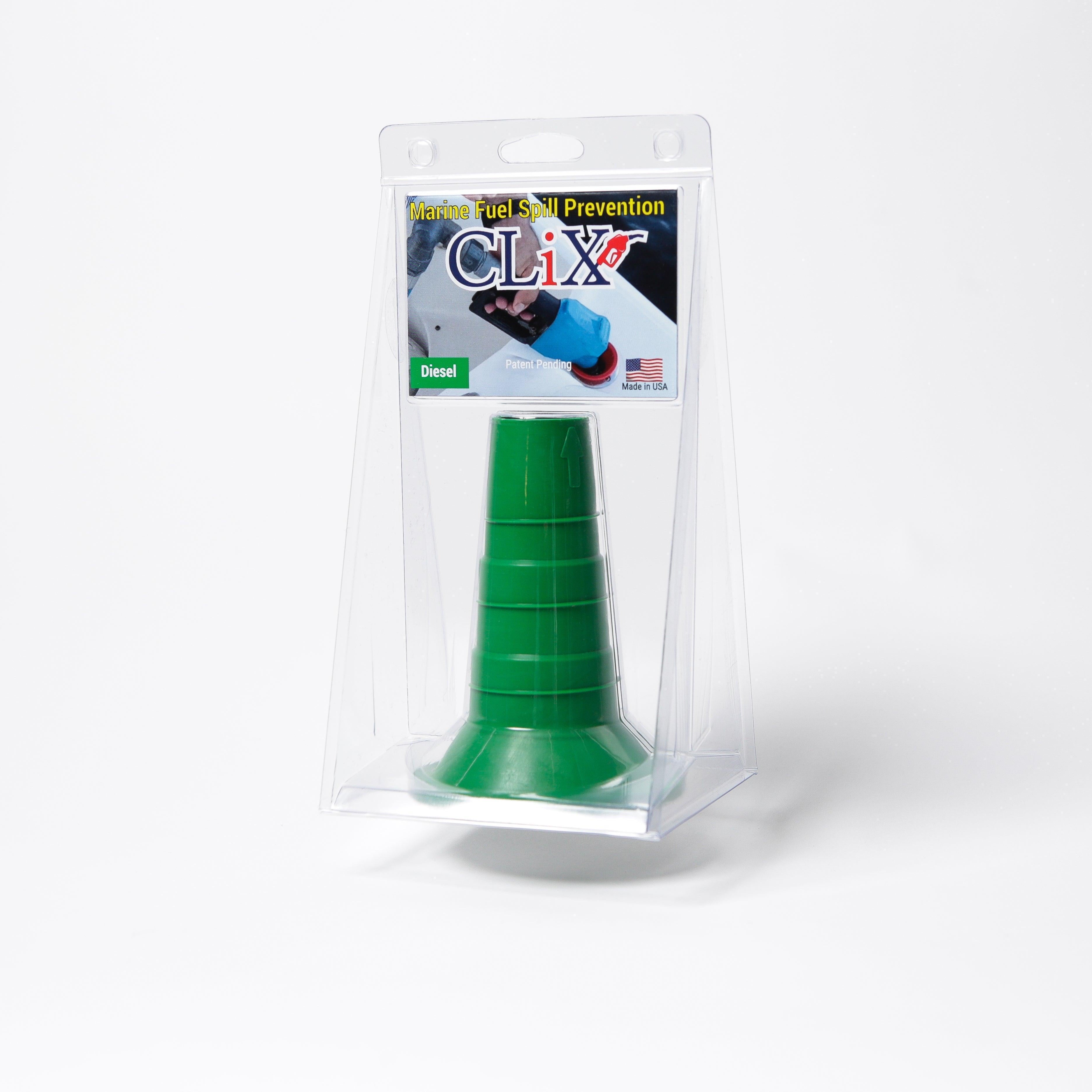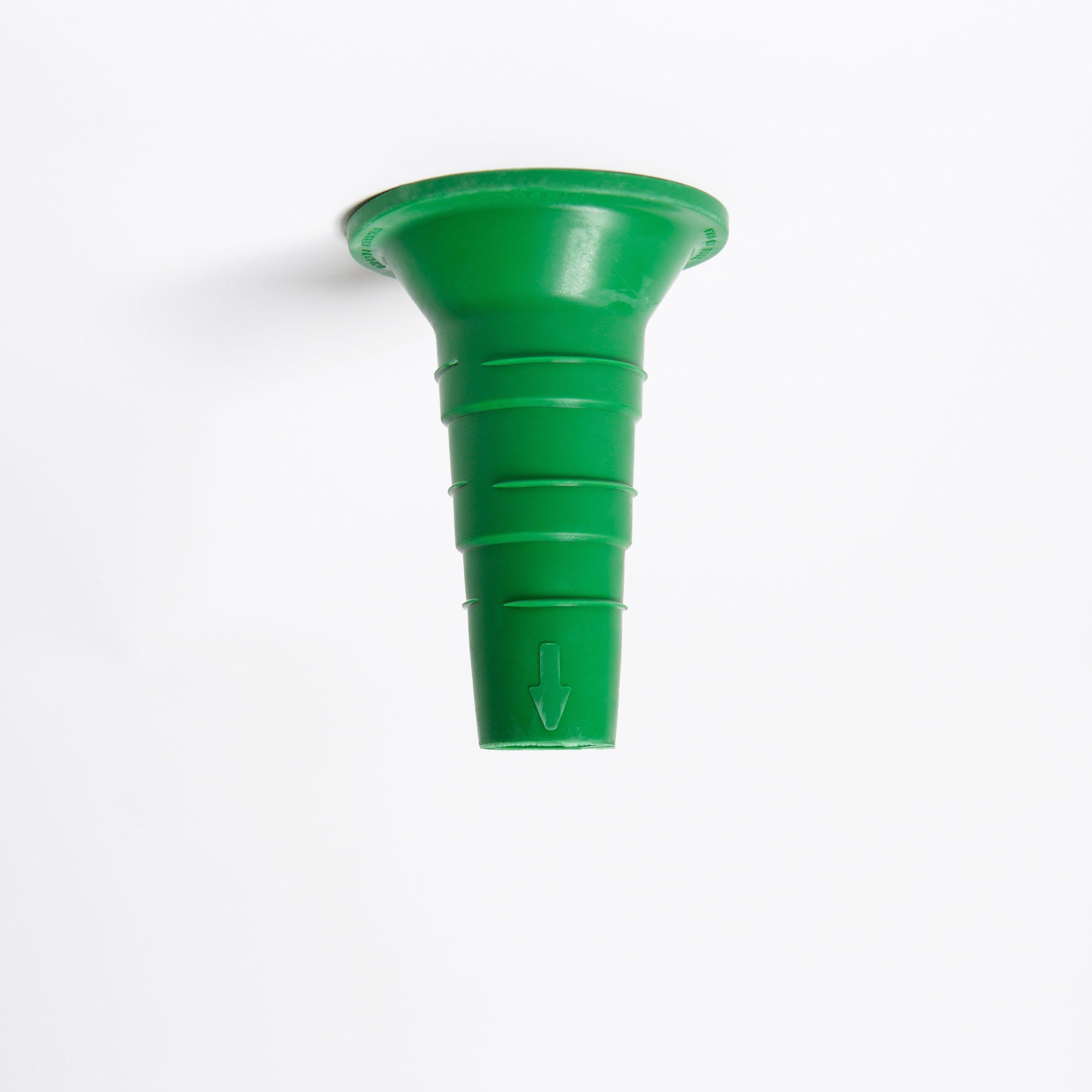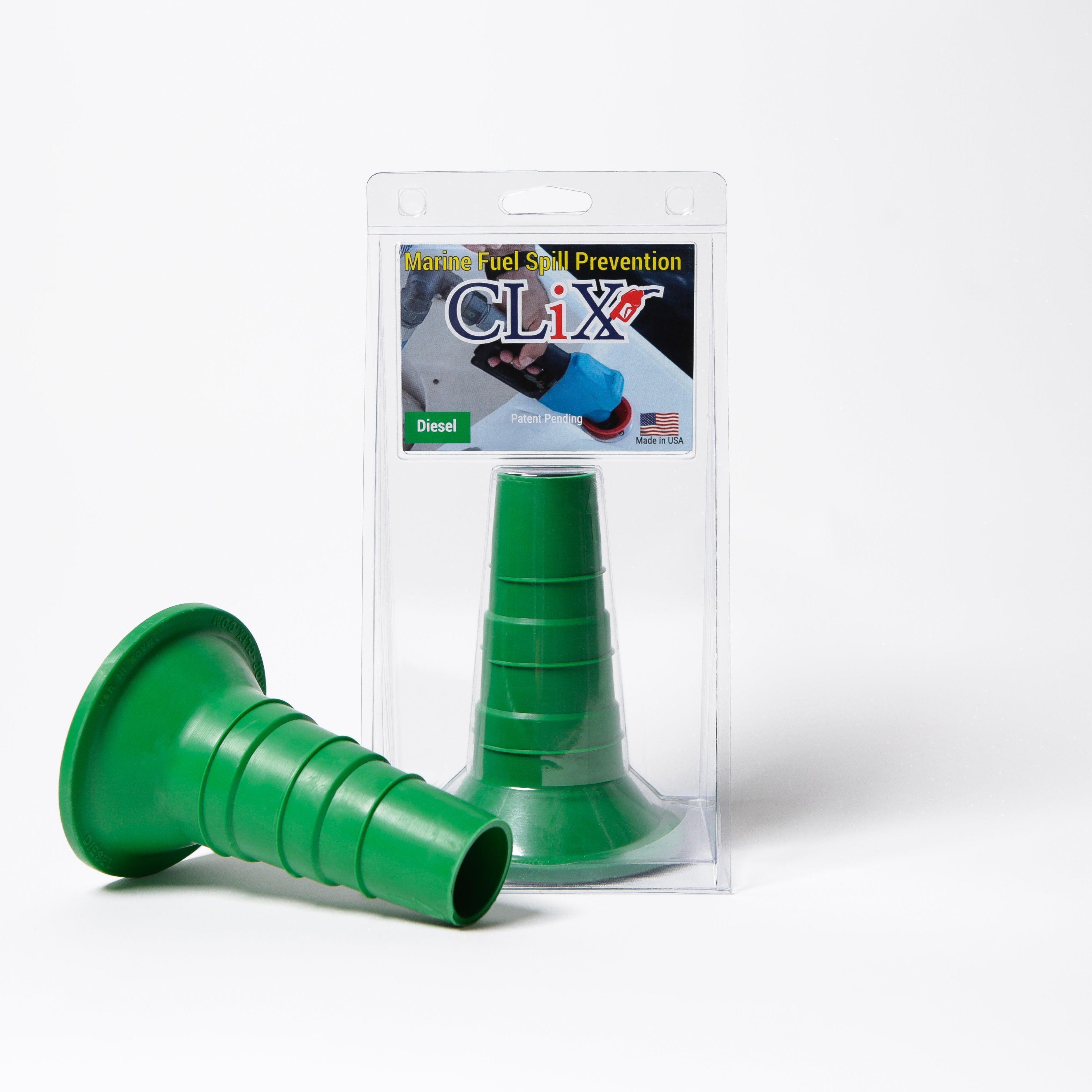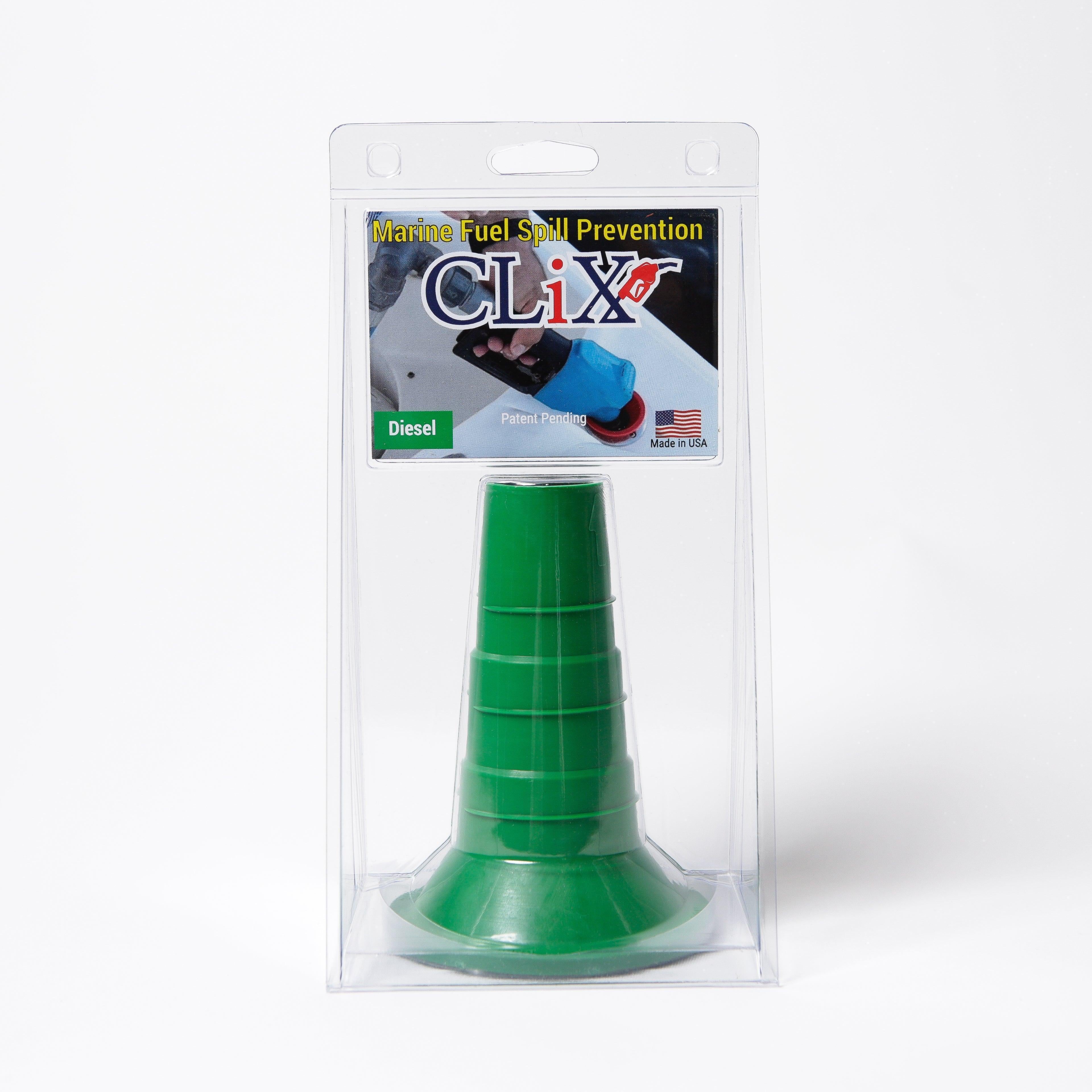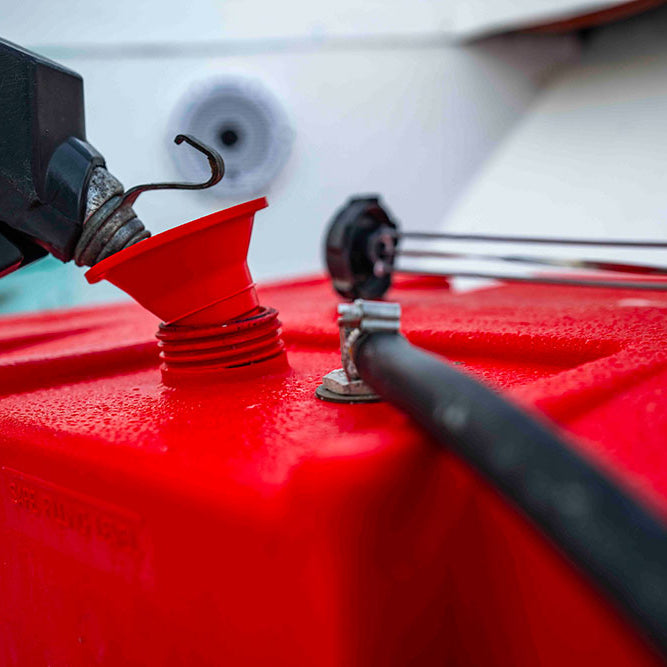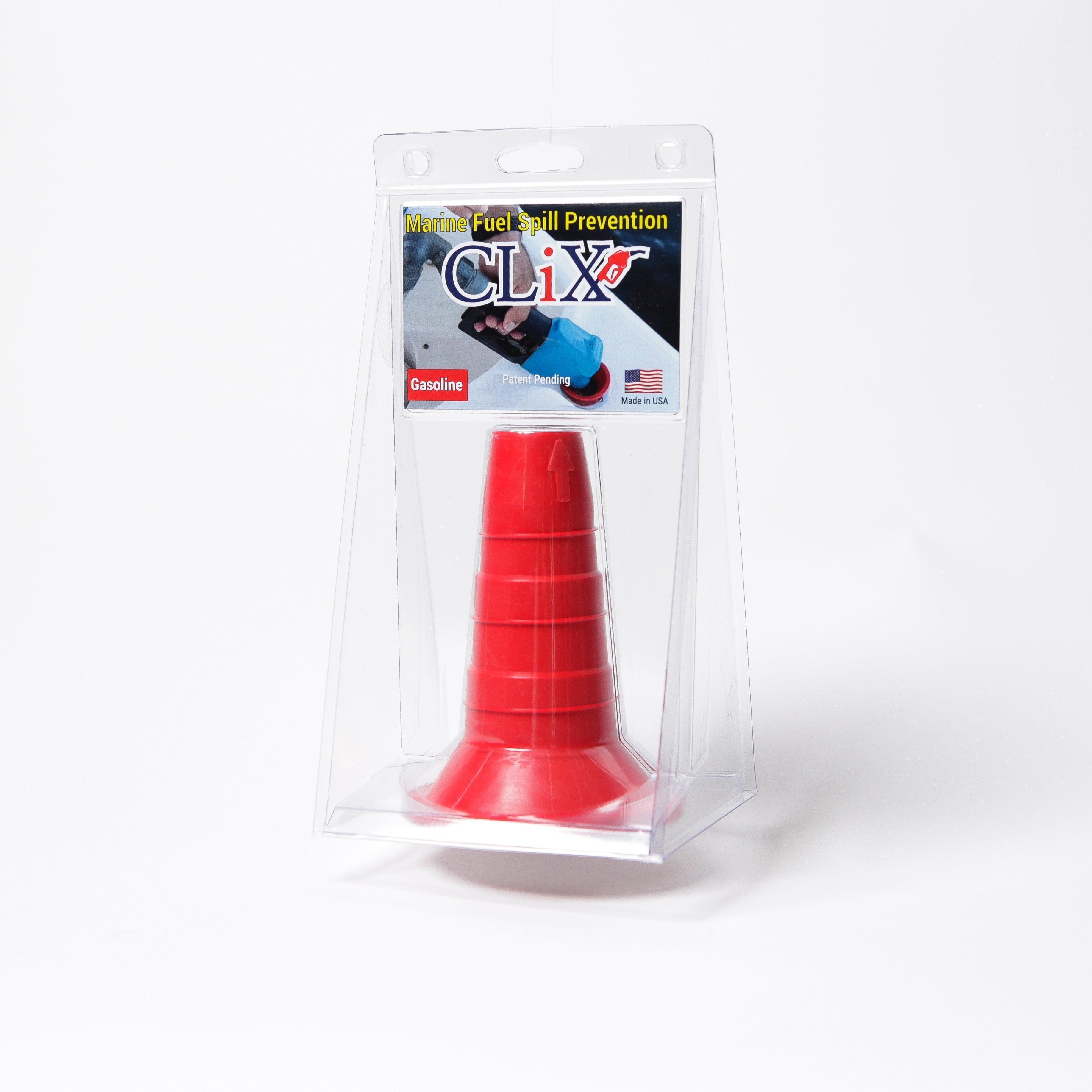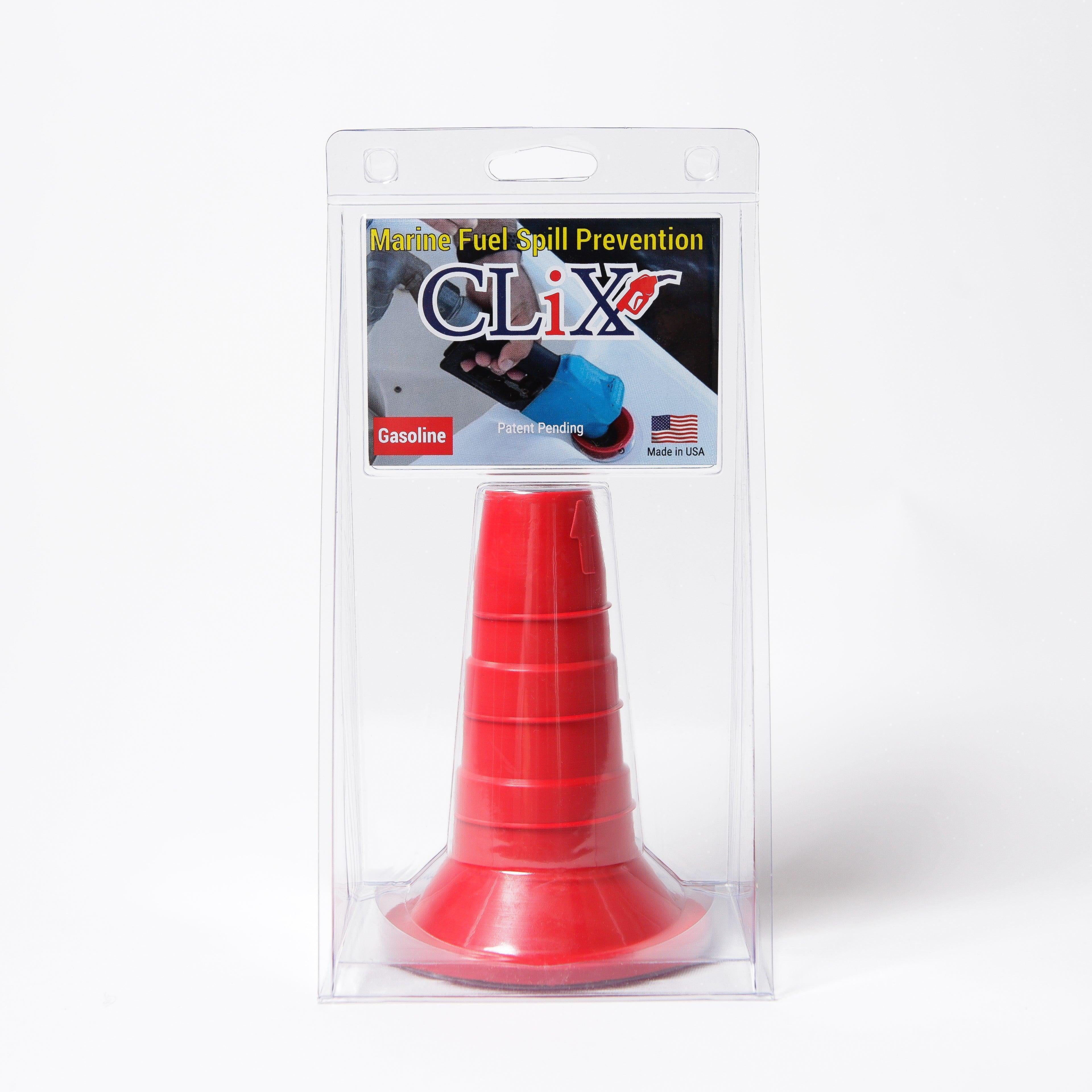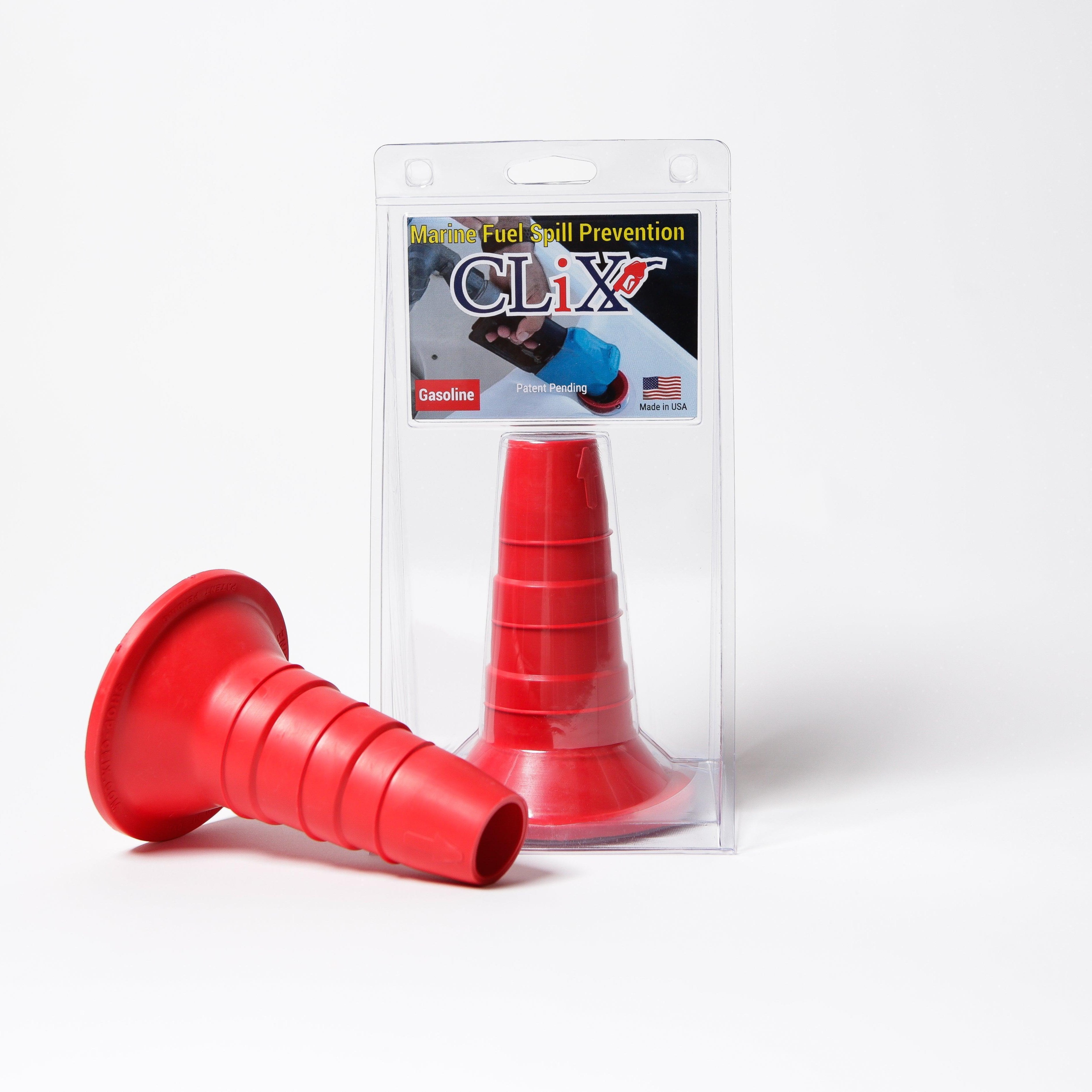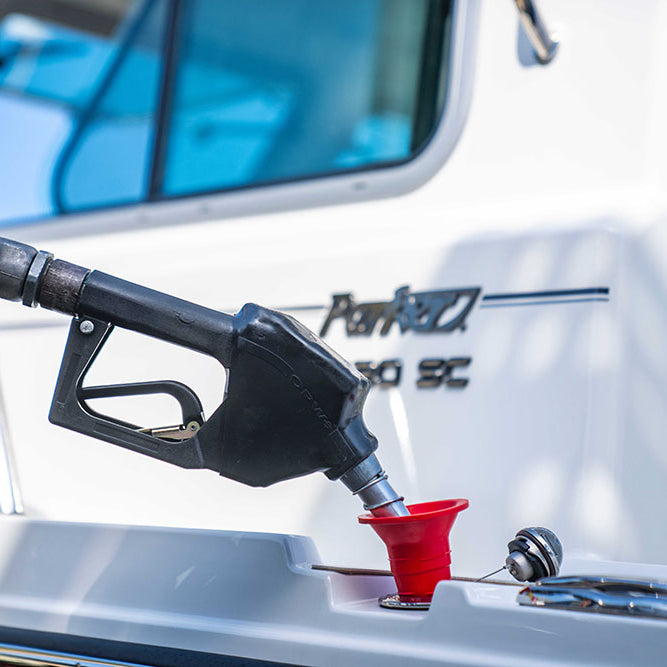When a diesel spill happens, what you do in the first few moments can make all the difference. The goal is to quickly and safely get the situation under control. Your immediate actions—ensuring personal safety, stopping the leak, and containing the spill—are what separate a minor cleanup job from a costly environmental headache.
Your Immediate Actions After a Diesel Spill
The seconds after a spill can feel chaotic, but a clear head and a steady hand are your best tools. The main objectives are simple: keep people safe, stop more fuel from escaping, and prevent it from catching fire. It's like emergency first aid for a fuel incident, and every second truly counts.
To help you act fast, here’s a quick-reference checklist for what to do in the first 15 minutes.
Initial Spill Response Checklist
| Action Item | Purpose | Key Considerations |
|---|---|---|
| Assess Safety | Protect yourself and others from immediate harm. | Check for fumes, especially in enclosed areas. Is the ventilation adequate? |
| Eliminate Ignition Sources | Prevent a fire or explosion. | Shut off engines, kill pilot lights, and stop any hot work (welding, grinding). |
| Secure the Perimeter | Keep unauthorized people out and create a safe work zone. | Use cones, caution tape, or even a vehicle to block access. |
| Stop the Leak (If Safe) | Minimize the total volume of the spill. | Can you turn a valve? Can you upright a tipped drum? Don't take risks. |
| Contain the Spread | Stop the fuel from reaching drains, soil, or waterways. | Use absorbent booms, socks, or even dirt to create a dam around the spill. |
This checklist isn't just a list; it's your game plan for turning a potential disaster into a manageable event.
Assess and Secure the Area
Before you grab a single absorbent pad, your first job is to size up the situation. Your safety, and the safety of everyone nearby, comes first. Are you in a closed-off garage where fumes can build up, or are you in an open, well-ventilated yard?
Next, hunt down and eliminate anything that could spark a fire. We're talking about:
- Shutting down any running engines in the vicinity.
- Putting out all open flames, and don't forget about pilot lights on heaters.
- Stopping any work that creates sparks, like grinding or welding.
With the fire risk handled, rope off the area. Use caution tape, cones, or whatever you have on hand to create a clear boundary. This keeps curious onlookers out and gives your team a safe, defined space to work.
The most effective diesel fuel spill cleanup procedure begins with a rapid, confident assessment. Turning a potential disaster into a manageable event hinges on those first few minutes of calm, correct action.
Stop the Source and Contain the Spill
Once the area is secure, your next move is to cut off the fuel supply, but only if you can do it safely. Sometimes it’s as straightforward as turning a tipped-over 5-gallon can right side up or closing a leaky valve. Every drop you prevent from spilling is one less drop you have to clean up.
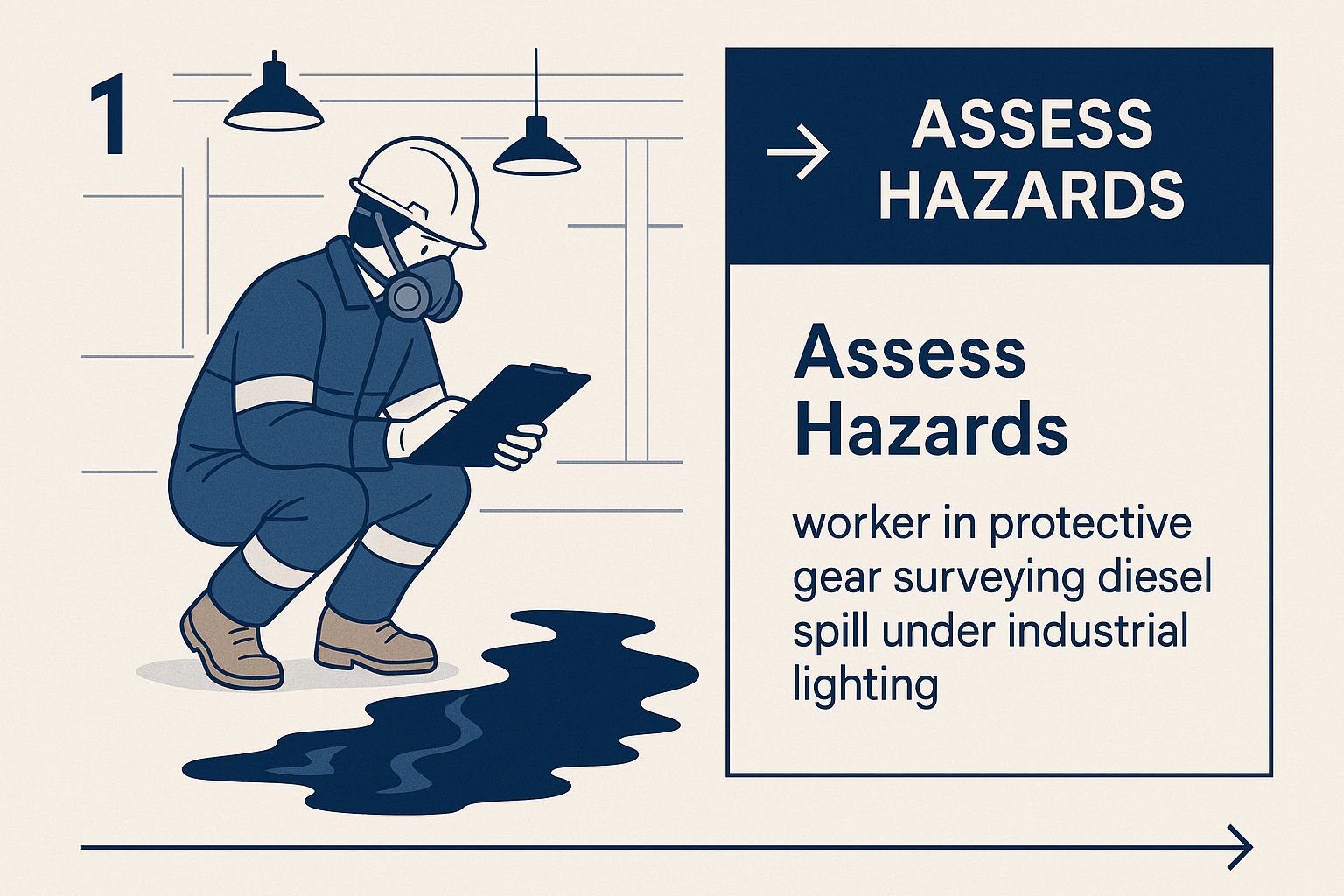
This image perfectly captures that first critical step: a trained professional taking a moment to assess the scene. This is the foundation of any safe and successful cleanup operation.
Getting Your Spill Cleanup Gear Ready
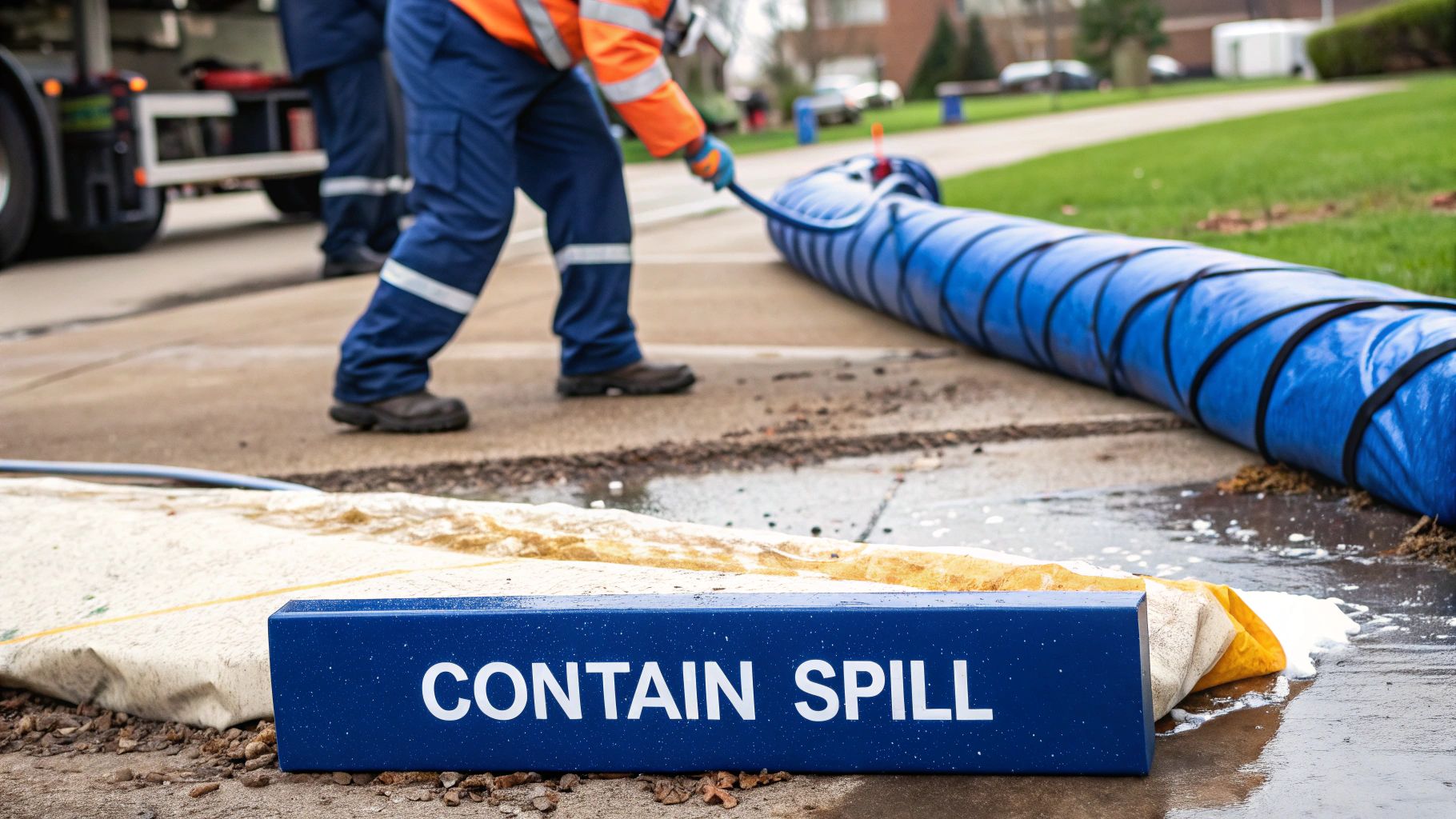
When a diesel spill happens, the clock starts ticking immediately. The last thing you want is to be scrambling for supplies while the situation gets worse. From my experience, being prepared isn't just a good idea—it's everything. A well-stocked, easy-to-grab spill kit is your best defense.
First Things First: Your Safety
Before you even think about the spill itself, you need to think about your own safety. Diesel fuel is a hazardous chemical, and your Personal Protective Equipment (PPE) is non-negotiable. It’s your barrier against some pretty nasty stuff.
- Chemical-Resistant Gloves: Don’t just grab any old work gloves. Diesel can seep through standard materials and get absorbed by your skin. You absolutely need nitrile or neoprene gloves to be safe.
- Splash-Proof Goggles: It only takes one stray splash to cause serious, permanent eye damage. Goggles that create a full seal are essential to protect your eyes from both the liquid and the fumes.
- Respirator: This is a big one, especially if you're working in a confined area like an engine room, a basement, or a garage with poor airflow. Diesel fumes can quickly become overwhelming and toxic. A respirator fitted with organic vapor cartridges is a must-have to protect your lungs.
The Right Tools for Soaking It Up
Once you're geared up and safe, it's time to deal with the mess. The absorbent material you choose really depends on where the spill is and how big it is.
For spills on rough, porous surfaces like concrete or asphalt, granular absorbents are your go-to. Think of materials like kitty litter or specialized clay compounds—they do an excellent job of pulling the diesel out of the surface. They’re also practical for larger messes on hard ground.
For smoother surfaces or for quick containment, absorbent pads and socks are fantastic. Pads are great for wiping and soaking up puddles quickly. The long, tube-like "socks" are perfect for creating a dike around the spill to stop it from spreading any further.
I can't stress this enough: invest in a pre-made spill kit. Having everything in one place turns a potential panic situation into a calm, controlled cleanup. It’s a simple step that saves critical time when every second counts.
Putting together a kit is a great start, but true readiness comes from having a clear plan. To make sure you've covered all your bases, check out a comprehensive fuel spill response plan template. This kind of preparation is what separates a minor cleanup from a major incident.
Cleaning Diesel Spills on Different Surfaces
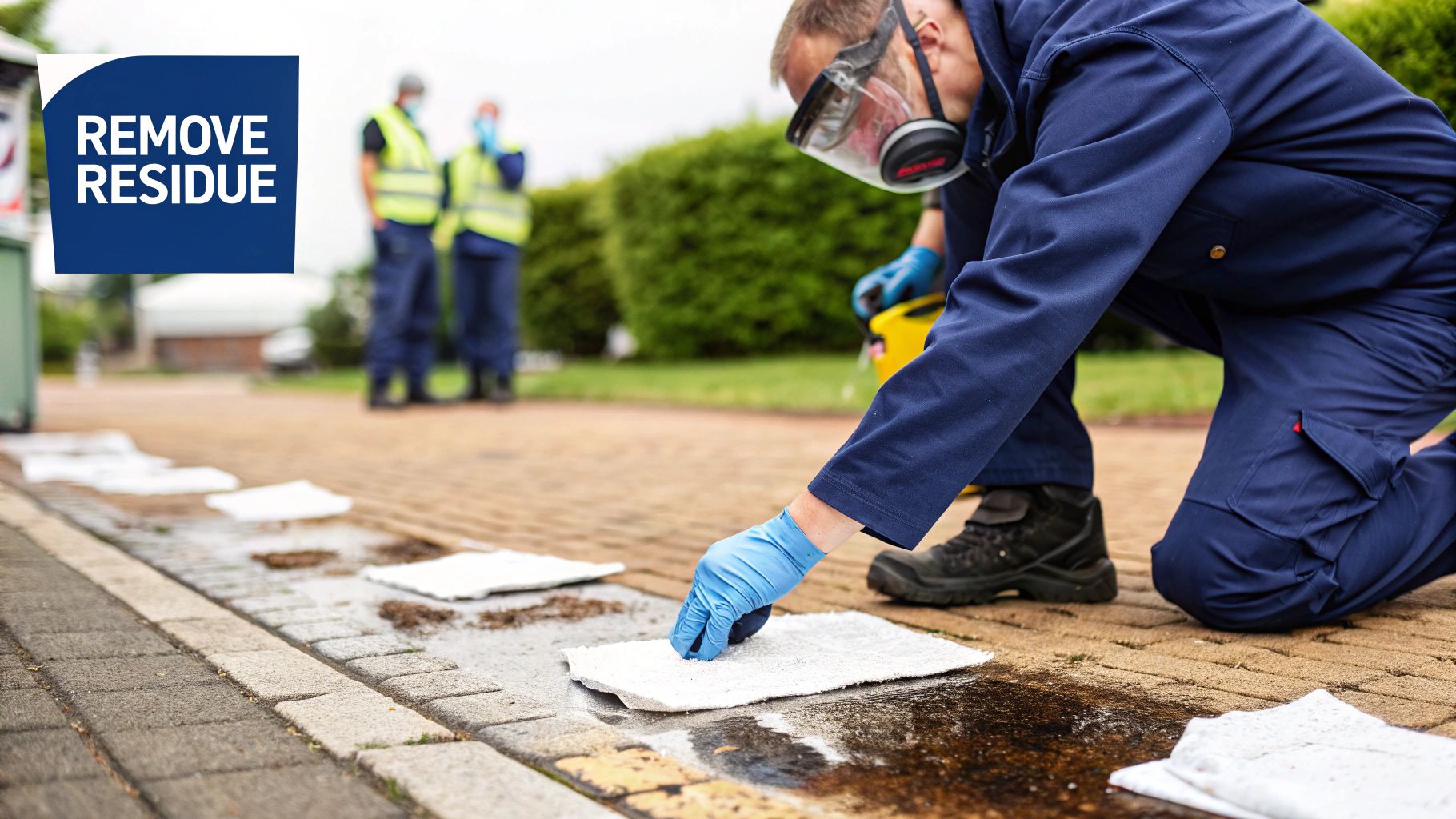
From my experience, I can tell you that there's no single magic bullet for cleaning up a diesel spill. The surface you're dealing with completely changes the game. A diesel fuel spill cleanup procedure that works perfectly on concrete will be useless on soil or water. It's all about adapting your approach.
Let's start with the most common scenario: a spill on hard, non-porous surfaces like the concrete or asphalt at your fueling station. In this case, granular absorbents are your go-to solution. I’m talking about commercial-grade clay compounds or, if you're in a bind, even kitty litter. These materials are great because they get into the tiny pores of the surface and pull the diesel out.
The trick is to apply the absorbent starting from the outside of the spill and working your way in. This builds a little wall that keeps the fuel from spreading any further. Give it time to work—don't be impatient. Once it looks fully saturated, you can sweep it up with a non-sparking broom and shovel and get it ready for proper disposal.
Tackling Spills on Soil and Water
When diesel seeps into the ground or hits a body of water, things get a lot more serious. Your focus has to shift from simple absorption to full-on containment and remediation to prevent a minor issue from becoming a major environmental problem.
- Soil Contamination: If a spill starts soaking into the dirt, your first move should be to dig a small trench or build a berm around it. This is a quick way to stop it from spreading. From there, the contaminated soil itself has to be dug up, put into secure containers, and treated as hazardous waste.
- Water Contamination: For spills that reach a pond, marina, or any waterway, you have to act fast. Absorbent booms are essential here; you’ll deploy them to circle the sheen on the water's surface. These floating barriers soak up the diesel and keep it from traveling. After that, skimmers can be brought in to pull the contained fuel off the water.
While cleanup costs for diesel are often lower than for crude oil, the work itself can be intense, especially depending on the location. For instance, a small spill in open water might be left to dissipate naturally. But when that same diesel hits a shoreline—like the 2020 Japanese vessel incident—it requires a massive manual effort. In one beach cleanup, more than 150 workers were involved, physically removing oil and contaminated sand. You can get a better sense of the challenges involved from this detailed report on fuel cleanup procedures.
Pro Tip: Even after you’ve soaked up most of a spill on concrete, you'll probably be left with an ugly, slippery stain. Grab an industrial-strength degreaser and a stiff brush to tackle what's left. It's a critical final step for getting your surface back to normal and, more importantly, getting rid of a serious slip hazard.
Managing Waste Disposal and Compliance
The cleanup isn't truly over just because the visible diesel is gone. In my experience, one of the most critical—and often overlooked—parts of the job is managing the aftermath. We're talking about all the contaminated absorbents, soil, and cleaning materials. If you mishandle this waste, you're not just risking a slap on the wrist; you could be facing serious fines and causing long-term environmental harm.
Think of it this way: every used pad, sock, and granule, along with any diesel-soaked soil, is now officially hazardous waste. That's not just a technical term. It means these materials are a real threat to people and the environment if they aren't disposed of correctly.
Proper Containerization and Labeling
First things first, you've got to get everything contained. Shovel all those saturated materials into approved, leak-proof containers. Heavy-duty steel or poly drums are the standard here. Whatever you do, don't just toss them into regular trash bags—they’ll tear and leak, creating another mess.
Once everything is drummed up, labeling is non-negotiable. Every single container needs a clear, accurate label that includes:
- The words "Hazardous Waste"
- A simple description of what’s inside (e.g., "Diesel-Contaminated Absorbents")
- The date the waste was first put in the container
- Your facility's name and address
This isn't just bureaucratic red tape. It's a legal requirement that ensures anyone handling that drum knows exactly what they're dealing with.
Partnering with Disposal Experts
You absolutely cannot just chuck these drums in the dumpster out back. You need to work with a certified hazardous waste disposal company. These are the pros who have the right permits, trucks, and knowledge to handle and dispose of this stuff according to strict Environmental Protection Agency (EPA) rules.
Choosing the right disposal partner is a huge part of the process. They'll give you a "manifest," which is basically a tracking document for your waste from the moment it leaves your site until it's properly disposed of. That manifest is your proof that you did everything by the book.
Understanding Reporting Requirements
Depending on how much you spilled and where it happened, you might have to report the incident to state or even federal agencies. For example, any spill that gets into a waterway almost always requires an immediate call. Learning how to prevent marine pollution is a vital skill, and proper reporting is a major part of that responsibility.
The scale of these operations is immense. The global oil spill remediation market was valued at a staggering US$168.8 billion in 2024, which gives you an idea of the massive financial and logistical effort that goes into cleanups worldwide.
Advanced Response and Spill Prevention
Moving beyond the basics of cleanup means adopting modern tools and, more importantly, a proactive mindset. The way we handle spill risks has changed dramatically, and a truly effective diesel fuel spill cleanup procedure now relies on technology that gives us a faster, more thorough response.
Think about bioremediation. This technique uses specialized microbes to literally eat away at diesel fuel, breaking it down naturally. It’s a game-changer in sensitive areas like soil or marshlands where you can't just scoop everything up. We're also seeing drones used for rapid spill assessment, giving us an invaluable bird's-eye view to judge a spill's size and direction without putting anyone in harm's way.
The technology for diesel spill cleanup has come a long way in just the last decade. For example, during a 2019 incident in the Gulf of Mexico, new-generation oil skimmers managed to recover over 70% of the spilled oil in just three weeks. That's a huge leap forward. Tools like drones and satellite imaging are now common, letting us quickly assess and monitor spills from a safe distance.
Building a Culture of Prevention
When all is said and done, the best strategy is always prevention. A forward-thinking approach is about stopping spills before they even have a chance to happen.
The most effective cleanup is the one you never have to do. A preventive mindset saves time, money, and protects our waterways from harm.
Getting ahead of spills starts with building a few key habits into your daily operations.
- Routine Equipment Checks: Make it a non-negotiable task to inspect fuel lines, hoses, and tanks for any signs of wear and tear. A small crack found today is a major spill avoided tomorrow.
- Secondary Containment: Always use spill pallets or containment berms under storage tanks and during fueling. They are your first line of defense, designed to catch any drips or leaks before they become a real problem.
- Consistent Training: Every single person who handles fuel needs to understand the risks and follow safety protocols to the letter. No shortcuts.
By embracing these advanced tools and making prevention a core part of your culture, you significantly reduce your risk. For more comprehensive resources on compliance and response strategies, organizations like the Environmental Protection Network offer excellent guidance. You can also dive deeper by reading our complete guide to expert fuel spill cleanup procedures.
Common Questions on Diesel Spill Cleanup
When you're dealing with a diesel spill, a lot of questions can pop up, and you're usually in a hurry to find the right answers. Having clear, no-nonsense guidance is crucial for getting things under control safely. Let's walk through some of the most common questions we get from operators and boaters.
What’s the Very First Thing to Do After a Diesel Spill?
Your top priorities are safety and containment, in that order. The first thing you should do is cut off any potential ignition sources. Shut down running engines, extinguish any open flames—anything that could create a spark.
Once the area is safe, your focus shifts to stopping the spread. Grab your absorbent socks, booms, or dikes and create a barrier around the spill. The absolute most important part of the initial response is preventing that diesel from getting into drains or waterways. If you can do that, the rest of the cleanup becomes much, much easier.
Can I Just Wash Away a Small Diesel Spill With Water?
Absolutely not. It might seem like a quick fix, but using water on a diesel spill is one of the worst things you can do. Diesel is lighter than water, so it will just float on top and spread out, turning a small, manageable problem into a much larger one.
This is how fuel quickly finds its way into storm drains and local water systems. You’ll end up with a significant environmental hazard and a major compliance headache.
Always reach for absorbents, never a hose. Water doesn't clean up diesel; it just spreads the contamination, making the situation far worse and increasing the environmental risk.
When Should I Call in a Professional Cleanup Service?
It's time to call in the pros if the spill is large, has already reached a waterway, or if you simply don't have the right personal protective equipment (PPE) and cleanup materials on hand.
Professional cleanup crews have the gear and training to handle hazardous materials safely. They also know exactly what's required to meet environmental regulations, which can save you from serious fines and liability down the road. If you have any doubt at all about your ability to handle the spill safely and completely, making that call is always the right move.
At CLiX Fueling Solutions, we’re firm believers that the easiest cleanup is the one you never have to do. Our automatic shut-off system is designed to prevent those costly and dangerous spills in the first place, keeping your boat and the environment safe. Discover a spill-free fueling experience with CLiX.


